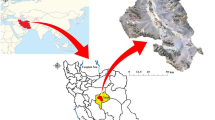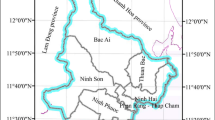Abstract
This paper presents the linkages of climate change and desertification, sensitivity to desertification, and the combined effects of these environmental hazards on land productivity. The objective of this study is to investigate the multifaceted nature and impact of climate change and desertification in Babura and identify ways to reduce their impact on the environment. This study applied adjusted MEDALUS methodology (Mediterranean desertification and land use) using ten (10) indicators that affected the study area. Remote sensing and GIS were the main techniques used in indices computation and mapping. Erdas imagine 9.2 software was used for the supervised classification to first achieved categorization of image in land use land cover (LULC) thematic features. Shuttle radar topography mission (SRTM) data using spatial analyst tool in ArcMap (extension of ArcGis 10.3) was used to extract digital elevation model and generated from it slope gradient. The ten indicators were integrated into ArcMap and each weighted from 1 to 2 using weighted overlay in ArcMap; thus, the higher the weighting the higher the sensitivity to land degradation. The ten indicators were categorized into climate, soil, and vegetation indicators based on most significant available parameters quantified and assessed on their perceived influence on desertification. The reclassification of climatic indicators, particularly the areas of high rainfall against the areas of low rainfall, assumed higher weighting indicating higher sensitivity to land degradation. Approximately 48.72% of the study area, with Babura being particularly critical, is highly sensitive to desertification, while most of the study area (676.79–5950.44 m2) consists of areas with very low erosion protection quality.

















Similar content being viewed by others

Data availability
Not applicable.
Code availability
Not applicable.
References
AbdelRahman MAE, Saleh AM, Arafat SM (2022) Assessment of land suitability using a soil-indicator-based approach in a geomatics environment. Sci Rep 12(1):18113. https://doi.org/10.1038/s41598-022-22727-7
Abiodun B, Lawal KA, Salami AT, Abatan A (2012) Potential influences of global warming on future climate and extreme events in Nigeria. Reg Environ Change 12:1–18
Abuza AE (2017) The law and policy on curbing desertification in Nigeria: a contemporary discourse. J Jurid Sci 42:65–103
Adamu I, Chiroma AM, Orimoloye JR (2017) Fertility and suitability evaluation of some selected sites within the great green wall (GGW) corridor of Jigawa State, Nigeria. J. Arid Agric 11:125–134
Adger WN (2003) Social capital, collective action, and adaptation to climate change. Econ Geogr 79:387–404
Afzali SF, Khanamani A, Maskooni EK, Berndtsson R (2021) Quantitative assessment of environmental sensitivity to desertification using the modified MEDALUS model in a semiarid area. Sustainability 13(14):1–19
Ahmed A, Abdullahi N, Jibrin MA, Hussaini A (2019) Drought perceptions and coping strategies among the marginalized and resource poor farmers in the Sahelian zone, Jigawa State, Nigeria. Int J Eng. Technol Manag Appl Sci 3:31–37
Akpodiogaga P, Odjugo O (2010) General overview of climate change impacts in Nigeria. J Hum Ecol 29:47–55
Amadi SO, Udo SO (2015) Climate change in contemporary Nigeria: an empirical analysis of trends, impacts, challenges and coping strategies. J Appl Phys 7:1–9
Aristizabal E, Garcia EF, Marin RJ, Gomez F, JuanGuzman, M (2022). Rainfall-intensity effect on landslide hazard assessment due to climate change in north-western Colombian Andes. Rev Fac Ing 103:51–66
Ater PI, Aye GC (2012) Economic impact of climate change on Nigerian maize sector: a Ricardian analysis. Ecol Environ 162:231–239
Berrang-Ford L, Ford JD, Paterson J (2011) Are we adapting to climate change? Glob Environ Change 21:25–33
Bestelmeyer BT, Okin GS, Duniway MC, Archer SR, Sayre NF, Williamson JC, Herrick JE (2015) Desertification, land use, and the transformation of global drylands. Front Ecol Environ 13:28–36
Bid S (2016) Change detection of vegetation cover by NDVI technique on catchment area of the Panchet Hill Dam, India. Int J Res Geog 2(3):11–20
Cervigni R, Riccardo V, Monia S (2013) Toward climate-resilient development in Nigeria. In: Directions in development. World Bank, Washington, DC
Croitoru A-E, Piticar A, Imbroane A, Burada C (2012) Spatiotemporal distribution of aridity indices based on temperature and precipitation in the extra-Carpathian regions of Romania. Theor Appl Climatol 109(1):1–12
Ebenezer TO (2015) Drought, desertification and the Nigerian environment: a review. J Ecol Nat 7:196–209
Elbasiouny H (2018) Assessment of environmental sensitivity to desertification, soil quality and sustainability in an area of the North Nile Delta, Egypt. Egyp J Soil Sci 58(4):399–415
Federal Ministry of Environment (FMEnv) (2008) Nigeria national biodiversity strategy and action plan 2016-2020. https://www.cbd.int/doc/world/ng/ng-nbsap-v2-en.pdf. Accessed 01/08/2021
Gad A, Lotfy I (2008) Use of remote sensing and GIS in mapping the environmental sensitivity areas for desertification of Egyptian territory. Earth Discussions 3:41–85
Gadzama NM (1995) Sustainable development in the arid zone of Nigeria. In: Monograph series No. 1, Centre for arid zone studies, vol 13. University of Maiduguri Press, Maiduguri, pp 18–30
Gadzama NM, Ayuba HK (2016) On major environmental problem of desertification in Northern Nigeria with sustainable efforts to managing it. World J Sci Technol Sustain Dev 13:18–30
Gavrilov MB, An W, Xu C, Radaković MG, Hao Q, Yang F, Guo Z, Perić Z, Gavrilov G, Marković SB (2019) Independent aridity and drought pieces of evidence based on meteorological data and tree ring data in Southeast Banat, Vojvodina, Serbia. Atmosphere 10(10):1–19
Grainger A, Smith MS, Squires VR, Glenn E (2000) Desertification and climate change: the case for greater convergence. Mitig Adapt Strateg Glob Chang 5:361–377
Haider H (2019) Climate change in Nigeria: impacts and responses. K4D Helpdesk Report 1:1–38
James GK, Jega IM, Halilu AS, Olojo OO, Oyewunmi AS, Shar JT, Onuoha H, Victor S, Mustapha S, Shehu I, Waziri AN, Mahmood MM, Salman KS, Isah A (2018) Assessment of environmental sensitivity to desertification in Katsina State, Nigeria. Env Ecol Res 6:545–555
Jonathan EO, Emmanuel IE (2017) The impact of climate change on the Nigerian economy. Int J Energy Econ Policy 7:217–223
Lamqadem AA, Pradhan B, Saber H, Rahimi A (2018) Desertification sensitivity analysis using medalus model and gis: a case study of the Oases of Middle Draa Valley, Morocco. Sensors 18:1–19
Lee EJ, Piao D, Song C, Kim J, Lim C, Moon J, Kafatos M, Lamchin M, Jeon SW, Lee W, Jung E, Kim J, Lim C (2019) Assessing environmentally sensitive land to desertification using MEDALUS method in Mongolia. Forest Sci Technol 15:210–220
Mgbemene CA, Nnaji CC (2016) Nwozor. Industrialization and its backlash: Focus on climate change and its consequences. J Environ Sci Technol 9:301–316
Nabiollahi K, Golmohamadi F, Taghizadeh-Mehrjardi R, Kerry R, Davari M (2018) Assessing the effects of slope gradient and land use change on soil quality degradation through digital mapping of soil quality indices and soil loss rate. Geoderma 318:16–28
Nwokocha CO (2017) Review of public administration and management an appraisal of the strategies implored by government to combating drought and desertification in the north-east geo-political zone, 2004-2014. Rev Public Adm Manag 5:1–6
Odorico PD, Bhattachan A, Davis KF, Ravi S, Runyan CW (2013) Advances in water resources global desertification: drivers and feedbacks. Adv Water Resour 51:326–344
Ojekunle ZO, Oyebamji FF, Olatunde KA, Amujo BT, Ojekunle VO, Sangowusi OR (2014) Global climatic change in Nigeria: a reality or mirage. Glob J Hum Soc Sci 14:1–8
Omijeh J (2008) Strategies for the control of desertification. FUTY J Env 3:72–83
Patz JA, Frumkin H, Holloway T, Vimont DJ, Haines A (2014) Climate change: challenges and opportunities for global health. JAMA – J Amer Med Assoc 312:1565–1580
Rahbaralam M, Zehtabian GR, Shams FR, Gholami H (2012) Evaluation of desertification intensity based on soil and water criteria in Alamarvdasht region. Adv Environ Biol 6:667–675
Sayne A (2011) Climate change adaptation and conflict in Nigeria. Special report: United States Institute of Peace, 2301 Constitution Ave., NW, Washington, DC 20037, 202:457
Shehu BM, Jibrin JM, Samndi AM (2015) Fertility status of selected soils in the Sudan Savanna Biome of Northern Nigeria. Int J Soil Sci 10:74–83
Shiru MS, Shahid S, Dewan A, Chung ES, Alias N, Ahmed K, Hassan QK (2020a) Projection of meteorological droughts in Nigeria during growing seasons under climate change scenarios. Sci Rep 10:2–13
Shiru MS, Shahid S, Dewan A, Chung ES, Alias N, Ahmed K, Hassan QK (2020b) Projection of meteorological droughts in Nigeria during growing seasons under climate change scenarios. Sci Rep 10:1–18
Sivakumar MVK (2007) Interactions between climate and desertification. Agric For Meteorol 142:143–155
Thelma MN (2015) Desertification in northern Nigeria: causes and implications for national food security. Pertanika J Soc Sci Humanit 3:22–31
Tiffen M, Mortimore MJ (2002) Questioning desertification in dryland sub-Saharan Africa. Nat Resour Forum 26:218–233
Verstraete MM, Schwart SA (1991) Desertification and global change. Vegetatio 91:3–13
World Health Organization (2015) Climate and health country profile – 2015, 1–8. https://iris.who.int/bitstream/handle/10665/208865/WHO_FWC_PHE_EPE_15.11_eng.pdf?sequence=1. Accessed 11/05/2021
Yamusa AM (2001) Prediction of rainfall in Nigeria using southern oscillation index (SOI). Desertation, Federal University of Technology, Akure
Yaro JA, Hesselberg J (2016) Adaptation to climate change and variability in rural West Africa. Springer, Switzerland
Acknowledgements
Sincere appreciation goes Nura Khalil Umar for providing the necessary maps and valuable comments and Ahmed Abubakar for valuable writing skills to make this paper possible. We are also very grateful for useful comments and critical suggestions from the editors and reviewers.
Funding
This study was support by the Tertiary Education Trust Fund, Nigeria.
Author information
Authors and Affiliations
Corresponding author
Ethics declarations
Conflict of interest
The authors declare that they have no competing interests.
Additional information
Responsible Editor: Amjad Kallel
Rights and permissions
Springer Nature or its licensor (e.g. a society or other partner) holds exclusive rights to this article under a publishing agreement with the author(s) or other rightsholder(s); author self-archiving of the accepted manuscript version of this article is solely governed by the terms of such publishing agreement and applicable law.
About this article
Cite this article
Ahmed, A., Ishak, M.Y., Umar, N.K. et al. Climate change and desertification syndrome: the interaction of drivers in the drylands of Nigeria and the possibility of reducing adverse changes. Arab J Geosci 17, 84 (2024). https://doi.org/10.1007/s12517-024-11888-6
Received:
Accepted:
Published:
DOI: https://doi.org/10.1007/s12517-024-11888-6



